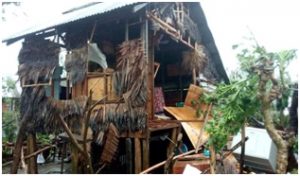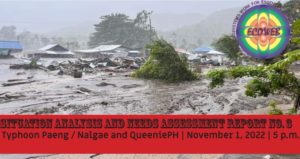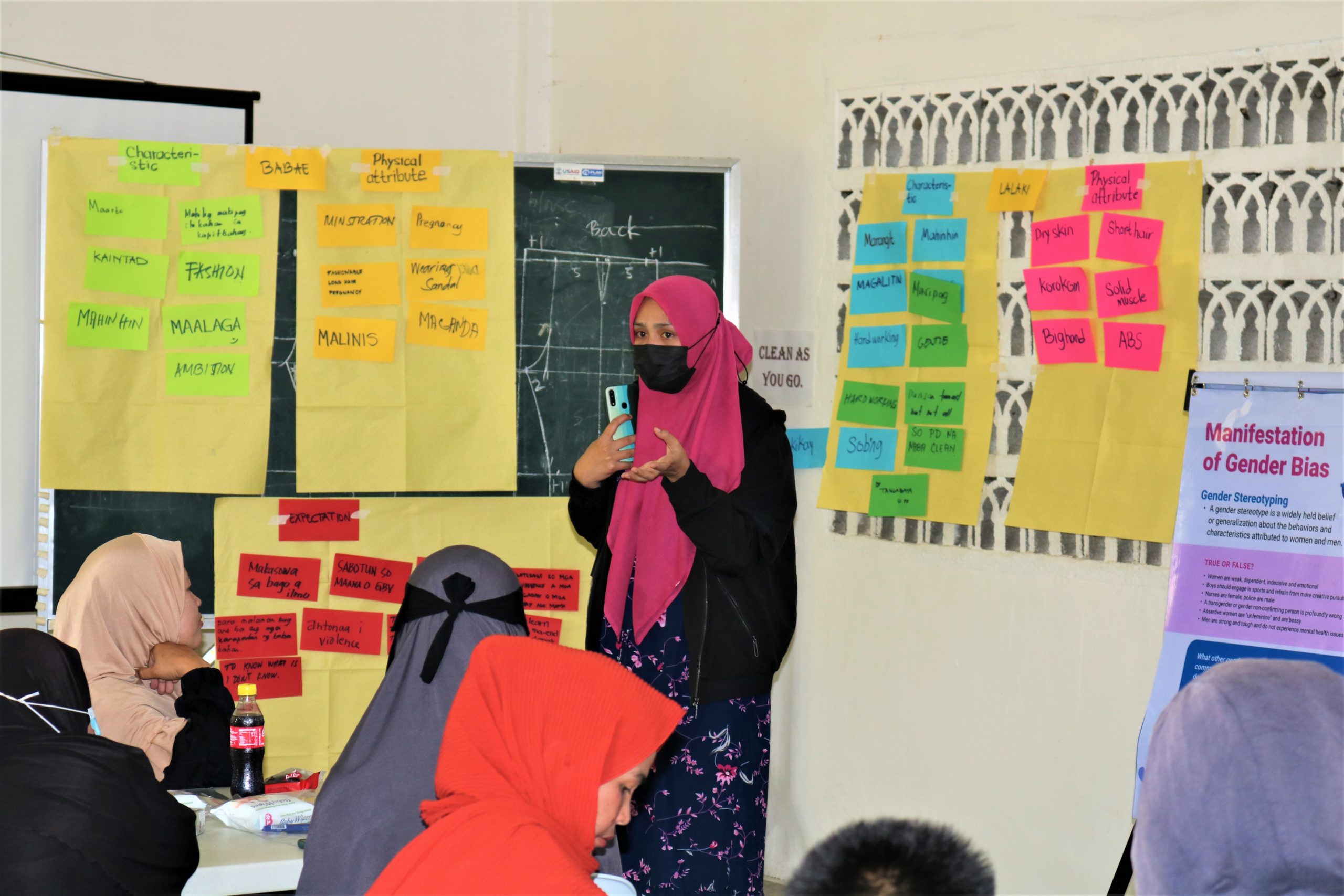by Carino V. Antequisa
“Sa ngayon mga 50% sa mga households along the main road mula San Julian to Oras ang apektado, lalo na ang mga bahay na made of light materials. Wala pang balita sa mga island and interior barangays.” (At present, about 50% of the households along the main roads from San Julian to Dolores are affected especially those made of light materials.) This is the initial assessment made by Efren Hipe, former Project Manager of ECOWEB’s Community DRRM Project in the municipalities of Dolores, Oras and San Policarpio in Eastern Samar, four hours after the Typhoon Ambo (Vongfong) carrying maximum winds of 155 kph made landfall in the San Policarpo.

ECOWEB staff, Nikki Dapanas, in charge of monitoring the Samar projects, updated that the last contact she made with volunteers in Oras was at mid-morning of May 14. They reported that local government units (LGU) of Oras, San Policarpo, and Dolores started the evacuation of coastal villages. There were already families that took shelter in the multi-purpose evacuation building constructed by ECOWEB with funding support from HELP Germany.
Initial damage
“My farm, one-half hectare planted with melon and one hectare fully planted with bananas, is 80% damaged,” said Efren who is now based in the town of San Julian, about 35 kilometers away from San Policarpo where Typhoon Ambo made landfall. “It’s good that the rice harvest season was just over and rice crops were not affected but the other crops especially vegetables and other food crops are badly damaged. It’s safe to conclude that 70-80% of agriculture crops in San Policarpo, Oras, Arteche, and Dolores are damaged especially the small farms.”

In the forefront of the typhoon belt
According to the Philippine Atmospheric, Geophysical, and Astronomical Services Administration (PAGASA), Typhoon Ambo made landfall in San Policarpo, Eastern Samar at 12:15 PM of Thursday, May 14, 2020. In its 2 PM bulletin, PAGASA reported that Ambo was already in the vicinity of Oras, Eastern Samar.
San Policarpo, Oras, Arteche, and Dolores are among the municipalities in Eastern Samar most vulnerable to strong typhoons as they face the Pacific Ocean. Eastern Samar municipalities face typhoon hazards almost every year: Super Typhoon Yolanda (Haiyan) in 2013 and typhoons Ruby (Hagupit) in 2014, Urduja (Kaitak) in 2017 and Ursula (Phanfone) in 2019, and then now Vongfong (Ambo). It was due to the impact of typhoon Ruby and Yolanda that ECOWEB initiated a Community-Based Disaster Risk Reduction and Management (CBDRRM) Program in the municipalities of San Policarpo, Oras, and Dolores funded by HELP Germany in 2016 until 2019.
Compounding the vulnerability due to its location is the high poverty incidence in the province. Eastern Visayas is the second poorest region in the Philippines, and three of the provinces in the region are part of the top 10 poorest provinces in the country: Eastern Samar (2nd), Northern Samar (9th), and Western Samar (10th).
Immediate needs
Asked about the immediate and medium-term needs of the affected families, Efren said, “Kailangan talaga ang pagkain at mga kagamitan para sa pag-repair ng mga bahay. Para sa livelihood recovery, kailangan talaga ang seeds, fertilizer at konting capital para sa labor and other farm inputs.” (We urgently need food and materials for house repair. And for livelihood recovery, we need seeds, fertilizer and some amount for labor and other farm inputs.)
Cash assistance
Asked on what would be the best way to provide assistance, Efren added, “Batay sa kalagayan ngayon na apektado tayo sa mga anti-COVID measures, the best way is through cash assistance. Pwede naman ang cash kasi hindi naman nasira ang mga stores and warehouses kasi preparado ang mga negosyante sa ganitong kalagayan dahil sa taon-taong pagsalanta ng bagyo.” (Base on the current situation that we are affected by anti-COVID measures, the best way is through cash assistance. That is feasible because the stores and warehouses are not damaged because the business owners are well-prepared for this situation due to the annual visit of typhoons.)
“Sa ngayon, zero infection ng COVID ang Eastern Samar dahil sa higpit ng local governments. At dahil nito napakahirap magpasok ng relief goods galing sa labas lalo na kung galing sa Maynila at Cebu na nandoon ang maraming infection. Dadaan yan sa matinding proceso. Kung emergency response, ang pinaka-praktical na paraan ay cash transfer talaga,” added Efren Hipe. (At present, Eastern Samar is zero COVID infection due to strict measures implemented by the local government. And because of this, it is very difficult to bring-in relief goods especially if its from Manila or Cebu where there is high incidence of infection. If for emergency response, the most practical way is via cash transfer.)
In perpetual recovery
“We are in perpetual recovery here in Samar,” Efren Hipe concluded, “every year, just as we started to recover, we are visited by another typhoon and we have to rebuild again.”
As of evening of May 14, damaged reports are still sketchy especially in the 15 barangays where ECOWEB implemented its CBDRRM program. However, from the previous experience in the aftermath of typhoons Ruby, Yolanda, Urduja and Ursula, food and house repairs were the most urgent needs. CVA



